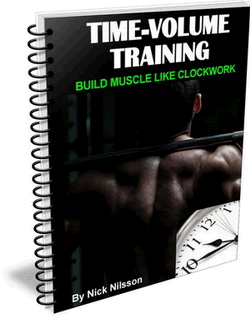By Dr. Mike T. Nelson, PhD, CSCS
Ever wonder what the most important training principles are that no one told you about that you had to stumble and crawl your way through to figure out?
These are the same ones that I pound into the skulls of my students so that they can think for themselves. Once you know these principles, you will be able to see the commonalities in training programs just like looking through the Matrix.
A quick story. . . Many years ago, when I started working as a trainer, a new client in his late 30s came to me with a laundry list of overuse injuries. His strength had also plateaued. Upon interrogation, said client coughed up a confession (like a bad hair ball) that his deadlift had not gone up for 2 years. In fact, he felt so miserable day in and day out that he had stopped deadlifting all together. Naturally, I asked him about his current training program. He pulled out his program on this ratty torn piece of paper that looked like one of the original pages of the Gutenberg Bible.
It wasn't too bad of a program, per se; and then I asked him how long he's been doing this particular program.
“4 years,” he said.
I stopped and looked at him like a two headed purple space alien.
“4 years?” I asked.
He sheepishly nodded his head in an affirmative looking as embarrassed as a dog that just whizzed on my floor.
As I mustered up everything I could to withhold my judgment, I asked why he been doing the same program for four years?
“My trainer told me him that this was the last program that I would ever need.” he replied.
So, he kept repeating the same 6 weeks sequence for 4 years.
Of course that is a radical experience. You, dear reader, are much more experienced, but it illustrates the point. The point is that if you don’t know the basic principles, you may be doomed to sewer of stagnation.
Here Are The Four Principles You NEED To Know For Fastest Results and to Reduce the Risk of Injury.
#1) Overload
The three main forms of overload are:
A) Volume
Volume = weight x sets x reps
This is simply how much work you're doing in the gym.
B) Density
Density = volume / time
Density is the volume divided by the time that it took you to do it. If you did (as old-school DeLorme) three sets of 10 reps, which goes back to 1945 (Todd et al., 2012), bench press on Monday morning and you used two-hundred pounds, the total volume you did was 3×10×200 = 6,000 lbs.
Let's say that took you a total time of 10 minutes and 30 seconds; you can therefore calculate your density.
10 min x 60 seconds = 600 seconds + 30 seconds + 630 seconds total time
6,000 lbs / 630 seconds = 9.52 lbs/ second
C) Intensity
This is simply how much weight is lifted for 1 rep or sometimes expressed as the percentage of your 1 rep max. In this example, it would be 200 pounds.
If you do the same thing over and over, your body really has no reason to change. No changes = no gainz. Not surprising, I know.
The catch here is that while you need to apply overload, you need to do it in an intelligent fashion. If physiology was simple and linear, you would see all the Monday Dude Brahs benching 400 pounds after only one two years of training by just adding 5 lbs to the bar each week.
Or as I saw once in a gym, a group of guys who would load up 315 on the bench, stand around attempting to look cool (miserable fail), deload it to 135 for their working sets, then back up to 315 lbs that nobody in their threesome ever attempted.
The goal is to apply overload for about 4 to 6 weeks, take a deload and then ramp back up again working to get a bit more overload in on the next cycle.

2) S.A.I.D.
The SAID principle is
Specific
Adaptation to
Imposed
Demand.
For instance, if you want to get better at deadlifting a lifting a heavy load (because it is awesome), then you should go to the gym and practice lifting heavy load.
It is almost too simple. Your body will get better at exactly what you do and also how you do it.
If you're working to increase your one rep max, get in as many high-quality sets at greater than 90% of 1RM is gonna be one of your fastest tickets to getting stronger safely in the shortest period of time.
You are specifically practicing the skill of lifting heavy load.
The downside is that you can’t do this every single training session, or, for most, even more than once a week; which brings us to….
3) Positive Transfer
At first blush, this appears to go directly against the SAID principle, but we all know that physiology is complex.
Positive transfer indicates that you got better at something without any direct practice. Argh – screw you complicated physiology.
For example if you are working to increase your deadlift to 495 since 5 wheels a side is just cool, you may find that doing front squats helps you get the bar off the floor faster or doing back extensions help you lock it out, or any other litany of different exercises.
While the goal was to increase your deadlift strength, you did it by finding the lifts that had the best positive transfer . . . You got better by doing something that was not a deadlift. The beauty here is that you can do more of this work once you have maxed out your SAID specific work.
#4) Adaptation
Your body is always adapting – even when you may not want it to.
The beauty is that physiology is never stagnant, and you always have the ability to change it.
The downside is that you can adapt in the wrong direction too. If you have been sitting all day, and your hips feel like you can bounce quarters off them into the next room, that is a negative adaption for lifting heavy ass weight off the floor (although a positive for that local hip bouncing quarter competition).
Your body was simply adapting to being in a seated position with the hip flexors being shortened all day; hence they will feel tight and short.
This is important to remember for extended time away from the gym too because you are removing the stimulus of stress on your body; thus, you will get weaker over a protracted period of time.
You see this when when we fire astronauts into microgravity in space. At that point, they do not even have the stimulus of gravity working on their systems and without countermeasures, they rapidly adapt to having less muscle, less strength and less bone mass (Tanaka et al., 2017; Bergouignan et al., 2016).
A good portion of their time during the day is loading their body to keep their muscle and bone mass. We see this same effect in bed rest studies on earth. Subjects are enrolled and confined to their bed for weeks at a time. Many time participants are not even getting up to use the bathroom. This is like a great idea to get paid to lay around and do nothing; but if you've ever spent a day in bed due to sickness or injury, I can assure you that you will not want to be in that study.
Adaption is a double edge sword, so use it to your advantage by applying the correct stimulus.

Summary = How to Use This Stuff...
Step 1: Define your goal
What is it you want to do. We will stick with the example of increasing your deadlift.
Step 2: SAID specific practice
Practice what you want to achieve to as close to it as you can, and then repeat over time.
Say your current deadlift 1 RM (rep max) is 475, and you want to hit 495. How often can you pull a nice rep at 475? Can you pull two nice singles in one training session? Can you do that same session once a week? Can you pull 480? Plan in your SAID specific work first as this will get you to your goal the fastest.
Step 3: Add Overload
Program in the 3 forms of overload. A good starting template is the following:
Bimodal Overload
Week 1: Volume overload at 3 sets
Week 2: Density overload at 3 sets, but a better density by 5-10%
Week 3: Volume overload at 4 sets
Week 4: Density overload at 3 sets, but a better density by 5-10%
Week 5: Volume overload at 5 sets
Week 6: Density overload at 5 sets, but a better density by 5-10%
Week 7: Taper and retest 1 RM
Or
Old School Volume
Week 1: Volume overload at 2 sets
Week 2: Volume overload at 3 sets
Week 3: Volume overload at 4 sets
Week 5: Volume overload at 5 sets
Week 6: Volume overload at 6 sets
Week 7: Taper and retest 1 RM
You get the idea. Mix and max volume, intensity and density.
Step 4: Positive Transfer
Program in the accessory exercises that will most likely transfer to your goal.
Make sure to do this AFTER you have maxed out your SAID specific work. This routinely shows up in programs as accessory work.
Step 5: Respect Adaptation
Keep in mind what you are adapting to both in the gym and outside of the gym. This includes nutrition, recovery, and mobility.
If your hips creak, crackle and pop like that bag of microwave popcorn you ate last night, think about what position they are in all day. Add some mobility work in during the day, and change position.
I wish someone would have told me a long time ago about these principles. Take the shortcut, and go put them to use. NOW.
References:
Bergouignan, A., Stein, T.P., Habold, C., Coxam, V., O’ Gorman, D., and Blanc, S. (2016). Towards human exploration of space: The THESEUS review series on nutrition and metabolism research priorities. NPJ Microgravity 2, 16029.
Tanaka, K., Nishimura, N., and Kawai, Y. (2017). Adaptation to microgravity, deconditioning, and countermeasures. J Physiol Sci 67, 271–281.
Todd, J.S., Shurley, J.P., and Todd, T.C. (2012). Thomas L. DeLorme and the science of progressive resistance exercise. J Strength Cond Res 26, 2913–2923.
Author Bio

Dr. Mike T. Nelson CSCS has spent 20 years of his life learning how the human body works, specifically focusing on how to properly condition it to burn fat and become stronger, more flexible, and healthier. He has a PhD in Exercise Physiology, and a MS in Mechanical Engineering (biomechanics). He's a faculty member for the Carrick Institute of Functional Neurology and has published research in both physiology and engineering journals. He's even been called in to share his techniques with top military agencies. In his free time he enjoys spending time with his wife, lifting odd objects, and kiteboarding. Find out more at www.miketnelson.com
If you want to learn how to match your nutrition to your exercise, go to www.flexdiet.com
![]()
More From Fitstep.com
| Countdown Alternating Sets for Legs | |
| (This is Nuts) Power-Start Lactic Acid Training for Legs | |
| Pizza, French Fries, Beer...and Other Diet Foods | |
| This Killer Core Exercise Will Leave You Crawling |
Share This Page...
---
Home -> Muscle and Strength -> Tips and Articles -> 4 Critical Principles



